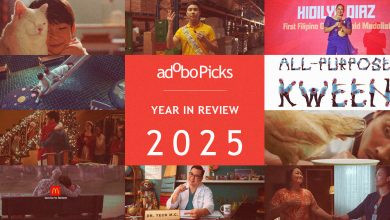SINGAPORE — The second day of the much-anticipated Spikes Asia awards is underway. We’ve seen ingenious works from APAC participants in all categories, with a peculiar movement in the Print & Publishing category.
Led by Spikes Asia Print & Publishing Jury President and BBDO Singapore Creative Chairman Tay Guan Hin, the category has received special attention from entrants and jurors alike. In an exclusive interview with adobo Magazine, Guan dissected the quality in this year’s entries, which works stood out the most, and how the Spikes Asia Academy is helping today’s generation of young creatives be well-equipped for modern solutions.
adobo Magazine: Earlier, we interviewed Simon [Cook], and he mentioned that there was a significant decline in print and publishing. How would you say that affects the judging process? Do you become more lax in evaluating the entries? Do you become more stringent in setting the bar high?
Tay Guan Hin: Even though the entries have dropped in some way, the quality has remained consistent. I think people, in submitting the work, are very choosy these days. They’re very careful in terms of what they submit. I think previously, there was a much wider variety of work. I think this time, since there are different categories, people are much more definitive in what they enter. So perhaps that could be why the whole category is declining.
But having said that, we will also task the jury and myself to find work that fits that particular category. As you can imagine, a lot of work can fit into many different categories because it’s very integrated, whereas print is very specific. So we will be focusing on some work that’s classic print with very great copywriting, for example. We wanted to focus on some of the crafts, some of the retouching, the execution that brings the idea to life.
All the print work was judged based on, “Does it have a brilliant idea?” And second is whether the brilliant idea has made some impact. Sometimes the impact could be behavioral changes. Sometimes the impact could be a very simple proposition, but executed or crafted in a beautiful way like in copywriting. I think copywriting as a craft is dying. People don’t read as much because we don’t pay attention to a lot of things these days. We have a shorter attention span. And even our attention span is sometimes shorter than a goldfish’s. But for print, if it’s printed in a newspaper, or printed in a magazine, people still do take time to read. And I think trying to highlight and trying to award great craft is something that we’re trying to do for this category.
There are not a lot of entries for print and publishing compared to the other categories. Among those few entries, are there still trends that you’ve observed? What are the standouts that you’ve seen?
I think the particular standouts are the ones that have an idea that creates a huge impact, and the way that print is used as storytelling. As you know, with print, it’s not moving. It’s quite still. Traditionally, it’s always been known as a platform that’s really difficult because you don’t have much — not many things are going for it. It’s a still image. So the trend still remains.
There are a lot of visual metaphors. There was a lot of craft in the copy, and also print as a medium. There was a particular one used for newspapers; it uses the position of where the newspaper ads are being placed. I think within the platform of print and the restrictions, I thought some solutions were really, really inventive. But most of all, coming back to the quality of print, the judges were awarding great storytelling with great execution. And I think execution in print has been lost. Obviously, with a lot of quick-posts that’s easy to throw away, we felt like we wanted to reward work that has innovation, but something also quite classic at the same time because I don’t think we should throw away what has made print good many years ago.
What would you say is the relevance of print and publishing at Spikes? How would you like that to go over the next few years?
I think as long as there’s still newspapers, as long as there’s still magazines, as long as we still have some printed medium that consumers are willing to pay for or to read, then it’s still relevant. If we think about photography, it’s also sort of moved on from analog to digital photography. And print, in some way, it’s about communicating something that’s on a flat piece of medium. So whether it’s a social post, or whether it’s an outdoor piece of work, if we are able to communicate a flat piece of work in a very interesting, engaging way, I think print will still survive over the years.
Let’s talk about the (Spikes Asia) Academy. I’ve read in your bio that mentoring young producers is one of your passions. How did the Academy come to fruition this year? Was it your initiative, that this is something that you wanted to do? Or were you tapped by Spikes?
Before Spikes approached me, I’ve been doing lots of mentoring and also workshops in schools. I was involved in setting up Singapore’s first young students competition probably 20 years back, called the Crowbar Challenge. And over time, I’ve also focused on trying to see how I can give back to the community in terms of not just teaching the young generation, but also giving them some inspiration, some real case study examples.
A lot of times, I feel like a lot of the new generation might not have a real direction in terms of how to produce good creative. You’ll hear feedback like, “Think outside the box, be creative, do something different, try something new.” What I like to impart was to give them real examples of framework, a start in how to get things going. The Academy was born out of a need in today’s world. So it’s not just for creative people, the Academy. We have a lot of participants; educators would be there, even a filmmaker was there — you’ll see a variety of people attending this Academy. And it was just to give them a taste on how we face issues, and how we solve problems today.
The theme of the academy is fear-proof. And fear-proof is born out of what’s happening around the world. Whether we’re going to keep our jobs, or whether AI’s going to take over our jobs, there’s so many things we fear, and we do fear the unknown. So to equip all the participants, it is just not creative work. We’ve got workshops to do personal branding, like on LinkedIn. We’ve also got a motivational speaker to change their mindsets because fear is sometimes much more than an internal issue, that you need to change the mindset. What we spoke about this morning in the Academy was that everyone goes through this fear. But it’s not the fear that we have to face, but the constant urge to overcome fear and to be resilient, because we are not immune to fear. It’s how we overcome fear that’s going to take us to the future.
In today’s ecosystem that is more visual, and where content is short-form, what do you think is the magic of audio?
The jury was very surprised that the work in radio and audio was exceptional. It was fantastic because we were not just judging radio scripts, per se. We were judging innovative use of sound. We were judging innovative use of sound and a song, and how that’s being used.
There were many examples where it’s going to give you a refreshing take on music. For example, a refreshing take on how sound is used to help someone. There was a piece of work that talked about helping the blind to see through sound. There are many ways that audio can be innovative enough to create something refreshing, new, and engaging at the same time. It’s not your typical 30-second or 60-second radio, but how sound, how noise, how things like the tapping on the table is able to create something that might be beneficial, and also create behavioral change.
I also know that sound and audio is super personal. Some might say that it’s the original targeted ads. How would brands stand out and be relevant to communities?
I think how brands can be relevant is understanding the target market — when you’re talking to Gen Zs, or talking to the millennials or someone more senior. Establishing your focus on a target market. And the next thing is how your idea fits into their passion, or taps into what they’re interested in.
For gaming, it could be a sound they use in the game that might be helpful for someone that’s visually handicapped. Or let’s say, a fast food company that will be using a sound made from the food that will be generated into a song that might be really relevant for Gen Z. Or it could be from people that passed away, and they brought their voices back to life through something else. The variety of the solutions will depend on the idea, and will also depend on the target market. But the most important thing is whether the creative work that you put together will generate a kind of engagement. Will it get people to participate? And will people be able to share after they’ve seen it? Because if they care, they’re willing to share.
adobo Magazine is an official media partner of Spikes Asia 2024.








